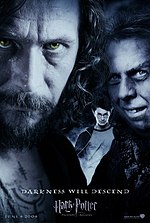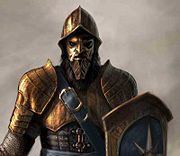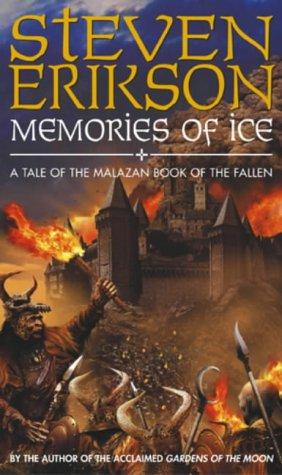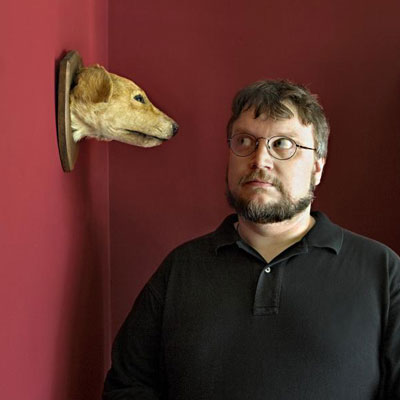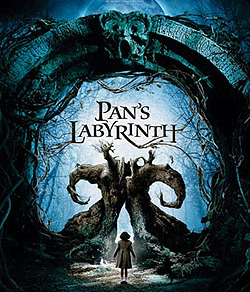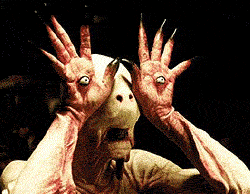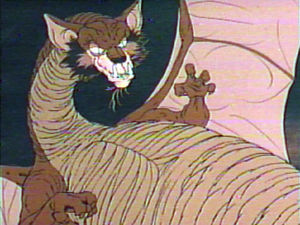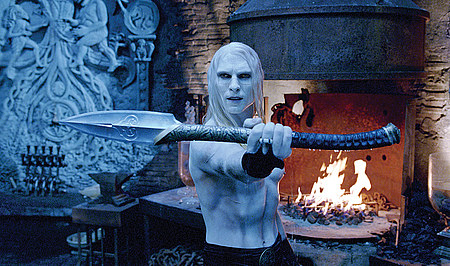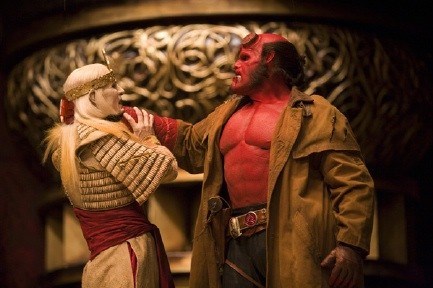Pan Versus Peter Pan; Or, Can’t We Have Some Adult Fantasy to Go with the Adulterated Fantasy?
Thursday, July 17, 2008
posted by Steve Tompkins
 Print This Post
Print This Post
Beginning in December of 2003 and continuing through 2004’s Oscar season, The Return of the King shook the earth like a mûmakil charge. Peter Jackson’s LOTR films served up something for almost everyone not named Grin: halflings, Howard Shore, monsters, Orlando Bloom for the maenads-in-training-bras, the Shakespearean dynastic/familial crises of the House of Eorl or Denethor and his sons, a cinematic siege with a fuse as slow-burning as that of Zulu, clashes between combatants in their thousands and tens of thousands that could hold their armored heads up in the company of Chimes at Midnight, Kagemusha, and Ran (the edged weapons became even edgier on the Extended Edition DVDs), and the realization that Frodo not only fails in, but is maimed by, his mission. So why have so many fantasy films since then settled for being merely a kindergarten of unearthly delights? The most “mature” spectacle to result from the Rings phenomenon has been the paroxysm of litigation pitting Jackson against New Line Cinema and the Tolkien estate against New Line’s corporate successors.
I have no quarrel with the Harry Potter films, at least not after the helm was relinquished by a Columbus who discovered only mediocrity. In fact Alfonso Cuaròn’s Harry Potter and the Prisoner of Azkaban ranks with The Two Towers and Pan’s Labyrinth as the finest film fantasy of this decade — interesting that it took a Mexican director to relocate Hogwarts from an amusement park in Crassville to Gothic highlands atmospherically patrolled by the spirits of George MacDonald and Isak Dinesen as well as the Dementors.
As soon as Inklings were identified as golden egg-layers Andrew Adamson’s 2 Narnia adaptations, The Chronicles of Narnia: The Lion, the Witch and the Wardrobe (2005) and The Chronicles of Narnia: Prince Caspian (2008) became inevitable (the more recent film has a severe case of Pelennor Fields envy, and its conquering Telmarines seem to have been airlifted straight from slaughtering the charges of eagle knights during la noche triste in Tenochtitlan).
But most of the fare has been insipid, innocuous, and in flagrant contravention of Tolkien’s dictum that “a safe fairyland is untrue to all worlds.” The Sci Fi Channel’s Legend of Earthsea and David Cunningham’s The Seeker: The Dark is Rising (2007) managed to antagonize Ursula K. LeGuin, Susan Cooper, and their sizable followings without appealing to the uninitiated. New Line Cinema and writer/director Chris Weitz took a not-so-subtle knife to the heart of The Golden Compass (2007) by downplaying the extent to which Philip Pullman was spoiling for a fight with C. S. Lewis. Devotees of the source material were turned off again, and insult was piled on injury as soundbite Savonarola William A. Donohue got to strut and crow. Eragon (2006, dir. Stefan Fangmeier), based on the novelty-less novel by young master Nep O’ Tism, achieved what would otherwise have been a feat of shuttle diplomacy beyond Henry Kissinger’s wildest dreams by uniting LOTR and Star Wars fans in derision.
Just as Middle-earth congealed into what John Clute scathingly describes as the “Identikit Fantasyland” of the Tolkien imitators, a “thought-free setting” and “natural home for unambitious tales,” knockoffs like Uwe Boll’s In the Name of the King: A Dungeon Siege Tale (2008) have confirmed that what was inspired and inspiring when Fellowship arrived after the lacerating autumn of 2001 has suffered a kind of progeria, an accelerated aging. New Zealand itself, so minty-fresh and revelatory back in 2001, so plausibly antediluvian as well as antipodean, has lately been in danger of becoming anodyne.
When the Jackson films were breaking records and what had been deemed the shatterproof glass ceiling of expectations, various reports indicated that Elric of Melniboné and Rand al’Thor (pity the screenwriter called upon to reinvent The Wheel of Time and rescue an epic fantasy from those thousands of pages of bickering and braid-tugging). Rumor even had it that Karl Edward Wagner’s Kane might exchange the Death Angel’s for the dealmaker’s shadow. Instead the tweeners and the YA category inherited the earth. The Fionavar Tapestry, created by someone who actually worked with a Tolkien to prepare the Tolkien’s manuscripts for publication, languishes undapted. Many if not most of David Gemmell’s novels cry out (in a manly, heroic way) to be filmed. M. John Harrison’s The Pastel City and A Storm of Wings await discovery as they have for decades, and no one has seized upon the opportunities that Matthew Stover’s Blade of Tyshalle and China Miéville’s Bas-Lag novels — Perdido Street Station, The Scar, and The Iron Council — offer to a visionary (and streetfighting) director. The city of Deepgate, suspended above abysses both literal and figurative in Alan Campbell’s Scar Night (2006), awaits its closeup, as do some of the fightingest, fallingest angels since Milton’s. Imagine Hodgson’s Night Lands with the schmaltz liposuctioned out, an “Ill Met in Lankhmar”/The Swords of Lankhmar combo platter, or The Broken Sword done up right to highlight its doppelganging hero and villain, Faerie-depopulating grudgematch between warrior races, and elegantly amoral elves to seduce the demon lover demographic.
Any one of Steven Erikson’s Malazan Book of the Fallen novels would require a budget the size of a Halliburton no-bid contract (although a take-no-prisoners, NC-17 version of Memories of Ice in particular haunts my dreams).
The same might seem to hold true for George R. R. Martin’s A Song of Ice and Fire. However, in 2007 Martin announced that HBO would be adapting the series, with he himself pitching in as co-executive producer and scripter of one episode per season: “With 12 hours to devote to each of the novels rather than the two to three that a feature film would allow, we should be able to present a faithful dramatization of the story that will please both my own readers and HBO subscribers who have never read a fantasy novel in their lives.” Well, seeing/Tivoing is believing; were it not for missteps, HBO would have no steps at all lately (Case in point: one of the star writers on the show that put them on the world domination map brings them the (David Chase-endorsed) idea for Mad Men, and they pass. . .because viewers couldn’t possibly be interested in a recreation of 1960, only one of the most mythic years in postwar American history). Still, should the project survive to an airdate Tyrion Lannister, Martin’s variation on the Dick Crookback theme, might become almost as much of a signature character as Tony Soprano or Deadwood‘s much-missed Al Swearengen.
In The Encyclopedia of Fantasy John Clute wrote that the appearance of LOTR in the mid-Fifties “marked the end of apology”; the appearance of the Jackson films in the Aughties should have marked the end of apology in another medium, but instead heralded an onslaught of poor excuses. We are seemingly becalmed in the bad old days of Legend and Willow; since 2005 filmed fantasy has been juvenile without being entertainingly delinquent. Adults, who are force-fed much more reality than children and tweeners and therefore are in much more urgent need of Clark Ashton Smith’s “freedom of fantastic things” as a dietary supplement for the imagination, are being poorly served.
If I long for hard-R fantasy films, it’s not just because of the sex and violence, although the former is usually welcome and the latter is often necessary. It’s because, to mangle the professor, sanitized fairylands are untrue to the world that is too much with us and the worlds to which we would fain beat feet. As a Howard enthusiast it’s not so much that I yearn for red mists around each axe-swing and sword-stroke as it is that I want those swings and strokes to be delivered in the contexts of the personal, tribal, or historical rages and hatreds that Howard devised for them, which pretty much demand the aforemenntioned adamantium-R rating.
But this far into the blog-post, instead of lamenting that John Boorman never made another fantasy film after Excalibur, or wishing that, on the evidence of “The Drowned,” his segment of Necronomicon (1994), Le Pacte des Loups (2001), and the delirious setpieces of Silent Hill (2006), Christoph Gans could be turned loose on an epic fantasy film for adults, I’m going to give thanks for the existence of Guillermo del Toro, criss-crosser of borders and genres, a citizen of the world, and the underworld, and the otherworld.
In his 2005 article “Angels and Insects: the Cinematic Spawn of Guillermo Del Toro,” David Greven says of the filmmaker’s early Cronos (1993), Mimic (1997), and Blade II (2002) “The images are audacious, ecstatic, ghoulish, and beautiful — they achieve something akin to a connective tissue binding the films together as an oeuvre that achieves intermittent greatness.” Blade II is worth lingering over for a moment: del Toro achieved the only watchable entry in the series by actually managing to surmount the tinted mirror of Wesley Snipes’ narcissism! And thereafter, from The Devil’s Backbone (2001) onward, intermittent greatness gave way to the full-time variety.

Del Toro has been a ping on my sonar screen since Cronos, but at times I’ve wondered, why so few Mexican stories? (And why no engagement with the deepest mythology, sun-baked and blood-slaked, of his native land?) Why are his two best films set during the climax and aftermath of the Spanish Civil War? Had a branch of his family emigrated from the mother country fairly recently? “I have witnessed an inordinate amount of violence in my life,” he once admitted, and in the commentary track for the Pan’s Labyrinth DVD, he recalls a street brawl in which he was beaten with a chain while a friend was beaten with a bottle, ruefully noting that the bottle never shattered as Westerns had trained him to expect. His father was held for ransom in 1997 and remained captive for months until some wealth was redistributed to the kidnappers’ satisfaction. Was the Matter of Mexico accordingly just too painful?
I was overthinking things. Turns out the haunted orphanage in the first draft of The Devil’s Backbone was a microcosm for the Mexican Revolution, not Spain’s Guerra Civil; the sweeteners required to secure a transatlantic co-production (the future of Spanish language cinema, as per del Toro) necessitated the shift. And the following quote doesn’t seem especially alienated:
There is a tradition in Mexico of craftsmanship that is called creating alebrijes. Alebrijes are mythical creatures that belong to no particular mythology or set of beliefs. They are fanciful five-headed dragons with the tail of a dog and the body of a cow. It doesn’t matter. They come straight from the brain of the artisan creating them. It is a culture that loves the bizarre. We love these monsters. We love creating them. The very act of doing them is the artistic gesture
“I collect any iteration of Chernabog the demon from Fantasia,” he has disclosed. Arthur Rackham is a favorite, too. As much a teratophile as Clive Barker or China Mièville, he argues “The worst thing in designing a monster is just referencing other movies,” and that negative superlative applies to much more than just monsters. Reassuringly, Del Toro is not just the sum total of the films he’s seen. In 2007 he told The Onion “I find I’m waking up really early now, just to read. Waking up at ungodly hours. But I try to keep up, religiously. When I was a kid, it used to be a book a day. Then a book a week. Now it’s a book every two weeks.” Worlds are most effectively and evocatively built with words, so the fact that this director’s appetite for same has been voracious and omnivorous is a major plus:
For many decades my main area of interest has been horror fiction: Algernon Blackwood, Arthur Machen, MR James, LeFanu, etc and classic Fairy tales and literature about the engines of Myth: unabridged Grimm, Andersen, Wilde, Bettelheim, Tatar, etc. Now and then I indulge in Science Fiction (not hardware oriented but more humanistic things) and thus I count Bradbury, Ellison, Sturgeon and Matheson amongst my favorites.
My area of interest gets much narrower when we deal with another genre. . . the genre that is shelved under Fantasy. As a youngster I read Moorcock, Clark Ashton Smith, Lord Dunsany, Lloyd Alexander, Fritz Leiber, Marcel Schwob, RE Howard and a few others. Nevertheless I was never propelled into an aleatory addiction to sub-genres like Sword & Sorcery or indiscriminate fantasies about magical this or that–Like any other genre or subgenre there’s a great abundance that makes it hard to discern when a new “trilogy” or “chronicle” comes from as genuine a place as Tolkien’s or derives from genuine fervor–religious or otherwise–like C.S. Lewis’ did.
 But here I am now: reading like a madman to catch up with a whole new land, a continent of sorts–a Cosmology created by brilliant philologist turned Shaman.
As if he grasped an existing universe outside our Platonic cave, Tolkien channels an entire world, weaving expertly from myth and lore. The outstanding virtue is that all this scholarly erudition doesn’t reduce his tales to mere taxidermy. He achieves an Alchemy all of his own: he writes new life in the freshly sculpted clay of his creatures.
I have, through the years become familiar with the very roots of Tolkien’s myths and the roots of Fafhrd or Elric or Hyperborea and many a time I have relished the intricate ways in which demonic wolves, shape-shifter and spindly-limbed pale warriors can be woven into those many tales that become, at the end, the single tale, the single saga–that of what is immortal in us all.
In creating Pan’s Labyrinth I drank deep of the most rigid form of Fairy Lore and tried to contextualize the main recurrent motifs in an instinctive rhyme between the world of fantasy and the delusions of War and Politics (the grown man’s way of playing make-believe) and in re-reading The Hobbit just recently I was quite moved by discovering, through Bilbo’s eyes the illusory nature of possession, the sins of hoarding and the banality of war–whether in the Western Front or at a Valley in Middle-earth. Lonely is the mountain indeed.
So, no, generally I am NOT a “Sword and Sorcery” guy or a “Fantasy” guy–By the same token, I’m not a sci-fi guy but I would make a film based on Ellison in a second- or on Sturgeon or Bradbury or Matheson. I’m not into Barbarians with swords but I would kill to tackle Fafhrd and Grey Mouser. . . and so on and so forth. . . I’m a believer but not a Dogmatic. I do the tales I love (regardless of what shelf Barnes & Noble classifies the book under) and I love The Hobbit. I love it enough to give it half a decade of my life and move half a world away to do it.
I’ve seen some raised hackles in response to the dismissal of “Barbarians with swords,” but that’s silly.
As with Antaeus, the strength of (non-whimsical) fantasy comes from having its feet, no matter how bizarrely shaped, on the ground, in touch with the earth earthly, and that ground is painfully dark and bloody in Pan’s Labyrinth, the Spanish title of which is El laberinto del fauno.
The suits worried, as suits do, that Americans would confuse the words “faun” and “fawn” — another entry for the Americans Be Stoopid annals of title-rethinks; it’ll be a miracle if Quantum of Solace isn’t rebaptized Teensy Bit of Comfort on the eve of its release in November. “Pan would be too dangerous a character to put in a fable like this,” notes del Toro, who knows his Machen and Saki. In the Pan’s DVD featurette “The Power of Myth,” he observes “The true power of fairy tale is that it is at the same time very simple and very brutal,” and the film explores Dunsany’s Beyond the Fields We Know while those that we do know are killing fields.
Ofelia, del Toro’s heroine, escapes to a Perilous Realm from one just as perilous, as the Franco-style fascism of Spain in 1944 polishes its jackboots and settles in for a long stay just as its exemplars are being bloodily expelled from France and Italy.
The faun of Pan’s Labyrinth mentions “old names that only the wind and the trees can pronounce,” and such names, as well as newer ones, are whispered through that movie and Hellboy 2, del Toro’s latest. He’s cautioned Tolkien fans not to read either film as a blueprint for The Hobbit:
We made a deliberate move away from the Celtic/Nordic aesthetics present in most fantasy films because we knew we could NOT out do bigger productions (like LOTR) at that game. We are a $85 million dollar film and we tried to find our own “look” so we endeavoured to create a very idiosyncratic melange of Arabic architecture and design and Oriental motifs. We took Japanese suit of armour patterns allowed it to be imbued by Celtic motifs, etc–you can see some of that in the trailer. Our Elfland is more akin to Dunsany or perhaps even Moorcock in its aesthetics, using the stark contrast of dark against white skin and golden eyes. Our magical world is broader and freer–even surreal at times–and suits the tone of this film. I am exceedingly aware of Genres and more so when I mix them and / or mix them together. Most of Hellboy will give you almost no indication of what will come to pass with The Hobbit. There is, however a PROLOGUE done with old wooden puppets that will share some faint traces that eventually you will be able to find in certain passages in the forthcoming movie. But even then, please do not take this as a verbatim through-line. When I started Hellboy 2 I had NO inkling that The Hobbit would really come my way and I wanted to use the Fantasy Worlds that lie beneath as a metaphor of all that mankind is extinguishing with its unending greed.
Greed will certainly be a through-line spanning the two projects. With the treasure within reach, most of the characters in The Hobbit come down with “dragon-sickness” (From time to time I amuse myself, and only myself, with thoughts of The Good, The Bad and The Ugly as a study of dragon-sickness in which the dragon is the Civil War). Del Toro, who opines on the Pan’s DVD that “Monsters are here in our world to help us understand it,” has already weighed in on Tolkien’s saurian vector:
Smaug should not be “the Dragon in The Hobbit movie” as if it was just “another” creature in a Bestiary. Smaug should be “The Dragon” for all movies past and present. The shadow he cast and the greed he comes to embody- the “need to own” casts its long shadow and creates a thematic / dramatic continuity of sorts that articulates the story throughout. In that respect, Smaug the character is as important, if not more important, than the dragon. The character will emerge from the writing — and in that the magnificent arrogance, intelligence, sophistication, and greed of Smaug shine through.” In fact, Thorin’s greed is a thematic extension of this and Bilbo’s “Letting go” and his noble switching of sides when the dwarves prove to be in the wrong is its conceptual counterpart (that is a hard one to get through, Bilbo’s heroism is a quiet, moral one) and the thematic thread reaches its climax in the Bilbo / Thorin death bed scene.
Smaug probably won’t look much like this:
I don’t know if de Toro has read Tom Shippey’s The Road to Middle-earth, but if not he’s reached Shippeyesque conclusions on his own; to quote from the book “The character of Smaug is part of a Zusammenhang: nothing could be more archaic or fantastic than a dragon brooding on its gold, and yet the strong sense of familiarity in this one’s speech puts it back into the ‘continuum of greed,’ makes it just dimly possible that dragon-motivations on their different scale could have some affinity with human ones — even real historical human ones.”
Anyway, 2011 and 2012 will get here eventually; meanwhile Hellboy 2 is a compromise between comic book-derived blockbusterdom and much of the modern fantasy tradition, but not an uneasy compromise. Del Toro’s genre syncretism reinforces Mignola’s; Hellboy in comics form has always been the bastard son of a hundred maniacs, (the Dream Warriors reference is of course intended as a compliment). The superheroic makes room for the comic (Seth MacFarlane has been recruited to voice a new character who’s impossibly rigid and Teutonic though he exists only as gaseous ectoplasm) and the tragic: chiefly the People of the Earth, the Elves of Bethmora. When they die in Hellboy 2, they crumble into chunks of statuary, like vandalized sculptures, as if to suggest that the world has lost works of art as well as humanoids who still challenge the hegemons of homo sapiens. Del Toro’s King of Elfland, Balor, in effect decides after a disturbing victory that he is no Bran Mak Morn, for there is a weapon (the Golden Army) he will not use against Rome (mankind), at least not more than once. His revanchist son feels no such compunction, and Luke Goss’ Prince Nuada is an instant villain-upgrade from Rasputin in Hellboy (for anyone who’s even been in the same room as a copy of Nicholas and Alexandra, the mad monk failed to persuade as a threat to anything save the negotiable virtue of the Romanov court’s countesses). And in addition to furthering the mystique of Fair Folk martial prowess with his spear-work, Nuada is a fierce spokes-elf for Faerie irredentism. “Proud, empty, hollow things that you are,” he spits at a captive human audience, although subsequent sneering references to parking lots and shopping malls teeter on the edge of a Joni Mitchell paraphrase.
“If our days have ended, let us fade,” Princess Nuala implores her brother. “We will not fade,” he insists in defiance of almost everything that’s been written about Elves since LOTR; and when he’s called mad, he muses “Perhaps I am. Perhaps they have made me so.” He could be Moorcock’s Corum (the Prince with the Silver Hand where Nuada is Silverlance) or Tad Williams’ Feanorian Ineluki the Storm King talking.
The Silmarillion thrums with the potential for all-out war between Men and Elves; the greatest and most combustible genius of the elder people vows “We and we alone shall be lords of the unsullied light, and masters of the bliss and beauty of Arda. No other race shall oust us!” But the tension is never quite released on a battlefield, although we are told of the War of Wrath that “a great part of the sons of Men, whether of the people of Uldor or others new-come out of the east, marched with the Enemy; and the Elves do not forget it.” In the First Age the Elves, the willfully exiled Noldor in particular, are too numerous and powerful for any hostilities to last long; in the Third Age Men are gaining a similar ascendancy. That leaves the Second Age, wherein Sauron was a more immediate threat to both. Del Toro was speaking of Pan’s Labyrinth rather than Hellboy 2 when he commented “War creates an affirmation of ethics and morality or destroys them. It has that effect, there’s nothing in between,” but the insight bodes well for his treatment of The Battle of Five Armies in The Hobbit.
A troll market under the Brooklyn Bridge straight from the urban fantasy subgenre associated with Charles de Lint, royal twins whose minds and physical wellbeing are linked, a County Antrim necropolis emptied by “a plague of silence and death,” the dark underside of the notion of tooth fairies, and a gratifying plug for Tennyson’s “In Memoriam” — Hellboy 2 has plenty with which to occupy itself between slam-bang sprees. Yet its hero is never overshadowed (as seems to be the embryonic consensus about Batman/Bruce Wayne in The Dark Knight).
“Born from a womb of shadows,” in Nuada’s words, “and sent to destroy [humanity’s] world,” yet a lover of beer and TV (and cats; it’s amusing to think of the big red demon and H. P. Lovecraft bonding as ailurophiles), he cradles a baby while fighting for his life as sure-handedly as Chow Yun-Fat in Hard-Boiled. The character is a prole without being lumpen, his inner demons under control (for now) despite his infernal parentage: “So much of my aesthetic was formed by my dad,” Perlman says. “He was into Cagney, Bogart, Errol Flynn, Gable, Spencer Tracy, John Garfield.” Over at the NYT, A. O. Scott entitled his Hellboy 2 review “Like Bogey, But With a Really Big Fist.” Of Perlman’s participation in The Hobbit, del Toro promises, “If the screenplay has a character he can fit and fulfill he’ll be there. But if there isn’t we will wait for the next one.” Perlman as the growly, ursinoid Beorn is such luminously obvious casting that the director may well shy away for that very reason.
A movie that asks “Which holocaust should be chosen?” has a mind, and has things on that mind. Hellboy 2 doesn’t smell like popcorn, but rather like the flowers that bloom in the gore of its felled Forest Elemental, carpeting an undeserving stretch of Manhattan with supernal beauty. We need more movies like this, wherein boyish exuberance and adult shadings complement each other. In his DVD prologue to Pan’s Labyrinth, Del Toro says “This movie almost destroyed me, almost killed me,” and I hope The Hobbit is an equally intense moviemaking experience for him–in the best possible way, of course — as nothing would be a better guarantor that it will turn out to be be that kind of moviegoing experience, too.

